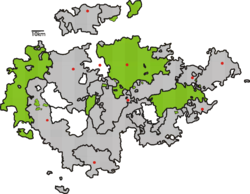
Saxe-Weimar-Eisenach
Historical German state from 1809–1920 / From Wikipedia, the free encyclopedia
Dear Wikiwand AI, let's keep it short by simply answering these key questions:
Can you list the top facts and stats about House of Saxe-Weimar-Eisenach?
Summarize this article for a 10 years old
Saxe-Weimar-Eisenach (German: Sachsen-Weimar-Eisenach) was a state of the German Empire, created as a duchy in 1809 by the merger of the Ernestine duchies of Saxe-Weimar and Saxe-Eisenach, which had been in personal union since 1741. It was raised to a grand duchy in 1815 by resolution of the Vienna Congress. In 1903, it officially changed its name to the Grand Duchy of Saxony (German: Großherzogtum Sachsen), but this name was rarely used. The Grand Duchy came to an end in the German Revolution of 1918–19 with the other monarchies of the German Empire. It was succeeded by the Free State of Saxe-Weimar-Eisenach, which was merged into the new Free State of Thuringia two years later.
(Grand) Duchy of Saxe-Weimar-Eisenach (1809–1903) (Groß-)Herzogtum Sachsen-Weimar-Eisenach Grand Duchy of Saxony (1903–1918) Großherzogtum Sachsen Free State of Saxe-Weimar-Eisenach (1918–1920) Freistaat Sachsen-Weimar-Eisenach | |||||||||||
|---|---|---|---|---|---|---|---|---|---|---|---|
| 1809–1920 | |||||||||||
| Anthem: Weimars Volkslied | |||||||||||
 Saxe-Weimar-Eisenach within the German Empire | |||||||||||
 Saxe-Weimar-Eisenach, shown within the Ernestine duchies | |||||||||||
| Status | State of the Confederation of the Rhine State of the German Confederation Federal State of the North German Confederation Federal State of the German Empire Federal State of the Weimar Republic | ||||||||||
| Capital | Weimar | ||||||||||
| Common languages | German Thuringian dialect | ||||||||||
| Government | Grand duchy (1815–1918) Republic (1918–1920) | ||||||||||
| Grand Duke | |||||||||||
• 1809–1828 | Karl August (first) | ||||||||||
• 1901–1918 | William Ernest (last) | ||||||||||
| Historical era | Middle Ages | ||||||||||
| 1741 | |||||||||||
• Merger of Eisenach and Weimar | September 20, 1809 | ||||||||||
• Raised to grand duchy | 1815 | ||||||||||
• German Revolution | 1918 | ||||||||||
• Joined Thuringia | 1920 | ||||||||||
| Currency | Saxon thaler (to 1857) Saxon Vereinsthaler (1857–1873) German gold mark (1873–1918) | ||||||||||
| |||||||||||
| Today part of | Germany | ||||||||||
The full grand ducal style was Grand Duke of Saxe-Weimar-Eisenach, Landgrave in Thuringia, Margrave of Meissen, Princely Count of Henneberg, Lord of Blankenhayn, Neustadt and Tautenburg.
The Saxe-Weimar-Eisenach branch has been the most genealogically senior extant branch of the House of Wettin since 1672.


